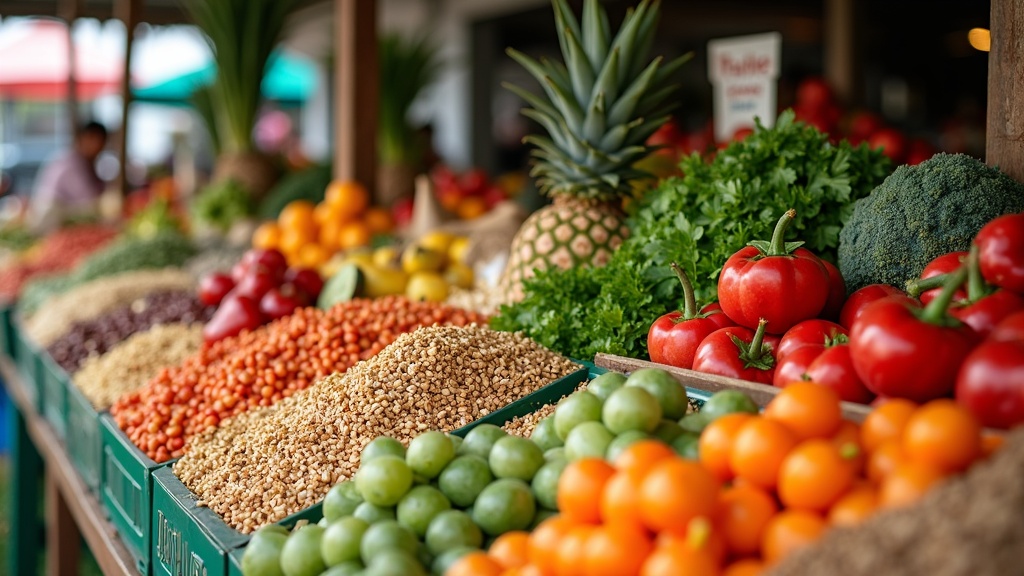Plantbased diets are everywhere these days.
You’ve probably noticed vegan and vegetarian options popping up at restaurants and even in your local grocery store’s freezer.
While the buzz around plantbased eating keeps growing, there’s a real question I get asked all the time: are these diets actually accessible to people living in lowincome communities?
From what I’ve seen and experienced, the answer is not so simple.
It’s a mix of promising options, some tough challenges, and ongoing changes in the food system that shape what’s really possible for people on tight budgets.

What Makes Up a Plantbased Diet, Really?
When people talk about plantbased diets, they could mean going full vegan, eating vegetarian, or simply choosing to eat mostly plants while still having animal products now and then.
At its core, a plantbased diet is one where fruits, veggies, grains, legumes, nuts, and seeds make up the foundation of your meals.
You don’t need to be eating expensive specialty vegan cheese or imported chia seeds to call it plantbased.
Think rice and beans, peanut butter sandwiches, and stirfried veggies over noodles.
Why do people pick plantbased options?
Health and environmental reasons are big motivators, but for some, it’s about affordability.
Basic staples like beans, lentils, potatoes, and oats tend to be some of the cheapest foods you can buy in most grocery stores.
That sounds like great news, but how easy is it to switch over to plantbased eating when your grocery budget is already stretched?
Barriers to Access for Lowincome Communities
Food access looks different depending on where you live.
From my own time living in both neighborhoods with big supermarkets and others with just a corner store, the types of food you can actually get your hands on change a lot.
Here are the main roadblocks I’ve seen come up for lowincome folks trying to go plantbased:
- Affordable Produce Isn’t Always Nearby: Fresh fruits and vegetables are cheaper in some places than others, especially if there’s a farmers market or discount grocery. But in so-called “food deserts,” where the nearest supermarket is a city bus ride away, your local options are usually shelfstable snacks, ultraprocessed foods, and little else.
- Time and Kitchen Resources Matter: It’s one thing to buy a big bag of dried beans or raw greens; it’s another to have the time and working kitchen to prep and cook them. When you’re working multiple jobs or sharing tight living spaces, quick convenience foods often win out over things that need to boil or roast for an hour.
- Lack of Culturally Relevant Foods: Plantbased eating isn’t the same everywhere. Some traditional diets are already plantforward, but in neighborhoods where stores don’t stock familiar ingredients, folks can’t always buy the staples they grew up with even if they want to stay plantbased.
- Perception of Cost: There’s a myth that plantbased eating is pricey. While whole grains and legumes are cheap, fancy faux meats or vegan cheese can cost way more than ground beef or cheese. Some people get discouraged by thinking they need to shop the organic or specialty aisle to eat plantbased.
How Budget Plantbased Eating Works in Real Life
When I was living off of ramen noodles, rice, and whatever was on sale, I learned a few tricks that helped me make my meals more plantbased without spending more.
If you look past the marketing hype around “plantbased” and focus on filling, affordable staples, you can definitely put together a satisfying, mostly plantpowered menu.
Here are a few practical strategies that work:
- Buy Bags, Not Boxes: Bulk bags of rice, oats, pasta, and beans are almost always cheaper than the preportioned boxed versions. If you have space, splitting big bags with family or neighbors can help everyone save.
- Frozen and Canned for the Win: Frozen veggies are just as nutritious as fresh, and they last way longer. Canned beans, rinsed to lower salt, are fast, filling, and usually only a dollar or two a can.
- Build Around What’s Available: Instead of shopping with a recipe, I look at what’s on sale. Making stirfries, pots of chili, or big pasta dishes around canned tomatoes, beans, and whatever veggies are cheapest keeps things easy and flexible.
- Make the Most of Community Resources: Food banks, produce coops, and community gardens sometimes offer free or lowcost produce. Signing up for SNAP or other nutrition assistance programs can stretch a food budget, especially since these programs now work at more farmers markets and grocery delivery services.
Systemwide Hurdles and Bright Spots
Changing your personal eating habits is great, but bigger changes at the neighborhood or city level really make the most difference for lowincome communities.
Here’s what’s going on at that broader level:
Food Deserts and Transportation
Millions of Americans live miles from a supermarket or affordable produce market.
Relying on public transportation for groceries means every trip is more complicated and more expensive.
Local policy changes, like bringing mobile produce trucks and popup markets into underserved neighborhoods, are helping in some places, but not everywhere.
Grocery Store Pricing Patterns
It’s true that basic plantbased staples like rice, dried beans, and potatoes are inexpensive by weight.
But “healthy” or “organic” branding pushes up prices, and sometimes lowincome stores simply don’t stock cheaper bulk basics.
Some neighborhoods carry mostly readytogo snacks or frozen meals because that’s what sells fast and is easier for stores to stock.
Nutrition Assistance Programs and Education
Government nutrition programs like SNAP (formerly food stamps) now let users buy more fresh and local produce in some states.
Nonprofits are also running cooking classes and community gardens to share lowcost, tasty plantbased recipes, which I find makes a huge difference.
When people get to taste and learn how to prep foods like lentils or collard greens, they’re much more likely to try it at home.
Common Mistakes and Messaging to Watch Out For
There’s a lot of pressure in online wellness circles to “go vegan for the planet” or “eat clean,” but pushing those ideas without considering budget and access just makes folks feel left out.
Here’s what I see going wrong most often:
- Equating Plantbased with Expensive Brands: You don’t need vegan meat or dairy substitutes to go plantbased. The cheapest, most filling foods are usually plain beans, grains, and tubers.
- Overlooking Cultural Eating Patterns: Telling folks to eat more kale and quinoa when their food roots are collards and cornmeal, or yams and blackeyed peas, misses out on affordable, familiar plantbased meals.
- Not Considering Prep Time and Tools: Assuming everyone has a full kitchen, hours to cook, or even a fridge leads to wellmeaning but impractical advice.
Solutions and Success Stories
Success is out there, and I’ve seen firsthand how robust community programs and smart shopping habits can open up plantbased eating for everyone.
These are some of the practical fixes and examples worth highlighting:
- Community Gardens and Urban Farms: Cities like Detroit and New York have transformed vacant lots into neighborhood gardens, supplying residents with fresh, free, or super cheap produce.
- SNAP Incentives for Fresh Produce: Programs like Double Up Food Bucks let food assistance dollars stretch farther at farmers markets, making fruits and veggies much more accessible.
- Plantbased Cooking Demos: Local YMCAs, libraries, and health clinics often run free classes teaching quick, lowcost plantbased recipes. You don’t need fancy equipment or ingredients.
- Creative Food Pantries: Some food banks are now making sure their shelves are stocked with dry beans, whole grains, and other plant proteins, plus sharing bilingual recipe cards for simple, tasty meals.
Frequently Asked Questions
Here are some common things folks want to know about plantbased diets in lowincome communities:
Question: Will I spend more if I eat a plantbased diet?
Answer:
Not if you focus on whole foods like beans, rice, bananas, and whatever produce is on sale.
Avoiding pricey meat substitutes keeps things very budgetfriendly.
Question: What if I don’t have a lot of time or kitchen tools?
Answer:
Almost everyone can use a microwave or stovetop.
Look for recipes with canned or frozen veggies and beans.
Onepot meals save time and cleanup.
Question: Are there plantbased versions of foods from my cultural background?
Answer:
Pretty often, yes!
Dishes like black bean stew, chickpea curry, vegetable stirfry, or lentil soup show up in lots of different food traditions without expensive ingredients.
Creating More Access: What Helps Most
Affordable plantbased eating isn’t just about personal groceries.
It’s about helpful community support and food system changes.
Here’s what makes the biggest impact:
- Bringing more fresh produce markets and mobile stores to underserved neighborhoods
- Expanding acceptance and benefits of food assistance at local markets
- More communityrun gardens and coops
- Free recipe demos and classes using basic, easytofind ingredients
- Standing behind more whole grains, beans, and fresh produce in food banks
A plantbased diet can fit most budgets, but having the right foods in reach, the knowhow to prepare them, and the time to cook them makes all the difference.
Progress is happening, even if there’s more work to do, to make plantbased eating a real choice for everyone, no matter their zip code or income level.
For those curious about making the switch, it’s worth checking out local resources and community
organizations that offer support and tailored guidance for lowcost, plantbased diets.
With ongoing changes in the food landscape and a growing spotlight on health and sustainability, the hope is that accessible plantbased options will keep spreading—making it a realistic option for every family.
